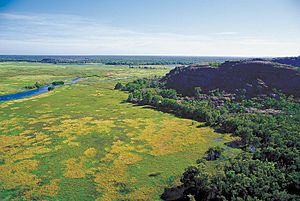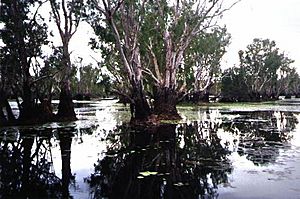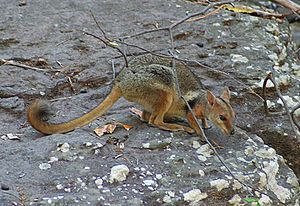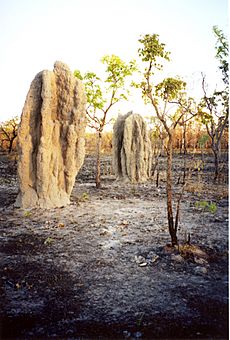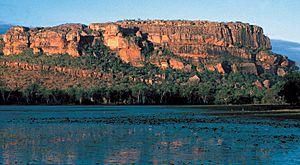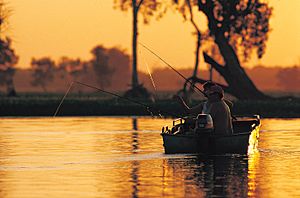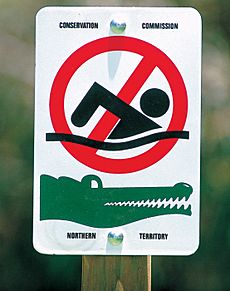Kakadu National Park facts for kids
Quick facts for kids Kakadu National ParkNorthern Territory |
|
|---|---|
|
IUCN Category II (National Park)
|
|

Kakadu Escarpment
|
|
| Nearest town or city | Jabiru |
| Established | 5 April 1979 |
| Area | 19,804 km2 (7,646.4 sq mi) |
| Visitation | 250,000 (in 2002) |
| Managing authorities |
|
| Website | Kakadu National Park |
| Footnotes | |
| UNESCO World Heritage Site | |
| Criteria | Cultural: i, vi; Natural: vii, ix, x |
| Inscription | 1981 (5th Session) |
| Extensions | 1987, 1992 |
| See also | Protected areas of the Northern Territory |
Kakadu National Park is a huge and amazing place in the Northern Territory of Australia. It's about 171 km southeast of Darwin. This park is one of the largest national parks in the world, covering an area of 1,980,400 hectares. That's almost half the size of Switzerland! It stretches about 200 kilometres from north to south and over 100 kilometres from east to west. Inside the park, you'll find the Ranger Uranium Mine, which is one of the biggest Uranium mines globally.
Contents
Discovering Kakadu's Rich History
Ancient Times and Aboriginal Culture
The name Kakadu comes from Gagadju, an Aboriginal language spoken in the northern part of the park. This area has been home to Aboriginal people for at least 20,000 years, and maybe even up to 40,000 years!
Kakadu National Park is famous for its many Aboriginal cultural sites. There are over 5,000 recorded art sites. These show the rich history and culture of the Aboriginal people over thousands of years.
The park's amazing natural beauty and cultural importance were recognized worldwide when it became a UNESCO World Heritage Site. This means it's on an international list of places that are super important for their culture or nature. Kakadu was added to this list in three steps: in 1981, 1987, and finally the whole park in 1992.
About half of Kakadu's land belongs to Aboriginal people. They lease this land to the Director of National Parks so it can be managed as a national park. The rest of the land is owned by the Australian Government. All of Kakadu is managed together by Aboriginal traditional owners and the Australian Government. This is done through the Kakadu Board of Management.
How Kakadu National Park Was Created
The idea for a national park in this area started as early as 1965. Kakadu National Park was officially created in stages between 1979 and 1991. This happened at a time when Australians cared more about protecting nature and recognizing the land rights of Aboriginal people.
Most of the land for Stage One of Kakadu was given to the Kakadu Aboriginal Land Trust in 1978. They then leased it to the Director of National Parks to be managed as a park. Stage One was declared on April 5, 1979.
Stage Two was added in 1984. Later, in 1991, more land was leased to the Director of National Parks. Stage Three was added after a big discussion about whether mining should be allowed in a special area called Guratba (Coronation Hill). The traditional owners did not want mining there, and their wishes were respected. The Australian Government decided there would be no mining at Guratba.
Early Visitors to Kakadu
People from China, Malaysia, and Portugal might have been the first non-Aboriginal explorers of Australia’s north coast. But the first written records come from the Dutch. In 1623, Jan Carstenz explored the Gulf of Carpentaria. Later, Abel Tasman visited in 1644 and was the first to write about meeting Aboriginal people.
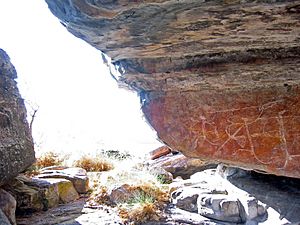
Phillip Parker King, an English navigator, explored the Gulf of Carpentaria between 1818 and 1822. He named the three Alligator Rivers because he saw so many crocodiles there, which he thought were alligators.
Ludwig Leichhardt was the first European explorer to travel by land through the Kakadu region in 1845. He followed Jim Jim Creek and the South Alligator River.
The Macassans from Sulawesi (Indonesia) were the first non-Aboriginal people to have long-term contact with Aboriginal people in northern Australia. They came every wet season, probably starting in the late 1600s. They sailed in boats called praus to collect trepang (sea cucumber), turtle shell, pearls, and other valuable items to trade. Aboriginal people helped them with this work.
The British tried to set up settlements on the northern Australian coast in the early 1800s. They wanted to claim the north of Australia before the French or Dutch. But these settlements failed due to problems like lack of food, sickness, and being too isolated.
Buffalo Hunters and Missionaries

Water buffalo had a big impact on the Kakadu region. By the 1880s, many buffalo had escaped from early settlements and their numbers grew huge. Hunting them for their skins and horns became a successful business. This industry employed many Aboriginal people during the dry season.
Missionaries also had a big influence on Aboriginal people. Two missions were set up in the early 1900s. The Oenpelli Mission, which started in 1925, operated for 50 years. Missionaries aimed to 'civilize' Aboriginal people, which sometimes meant changing their lifestyle, language, and beliefs.
Mining in Kakadu
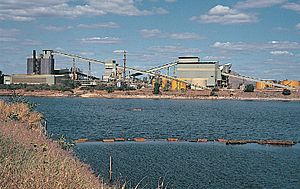
Minerals were discovered in the Top End in the 1870s. This led to small mining booms. Later, in 1953, uranium was found in the South Alligator River valley. Thirteen small uranium mines operated there for about ten years.
In the early 1970s, large uranium deposits were found at Ranger, Jabiluka, and Koongarra. The Australian Government looked into how this land should be used. It was decided that mining could happen at the Ranger site. The Ranger mine and the town of Jabiru have had many effects on Aboriginal people, who have different views about mining.
Kakadu's Climate: Wet and Dry Seasons
Kakadu is in the tropics, meaning it's close to the Equator. It has a monsoonal climate with two main seasons: the dry season and the rain season. There's also a "build up" period in between.

During the dry season (April/May to September), the weather is dry with low humidity and little rain. The average high temperature in June-July is around 32 °C. The "build up" (October to December) is very hot and humid, with impressive thunderstorms and lots of lightning. The average high temperature in October can reach 37.5 °C.
The rain season (January to March/April) is warm and wet. Most of the rain comes from monsoon weather systems. Sometimes, tropical cyclones bring very heavy rain. The average high temperature in January is 33 °C. Kakadu gets a lot of rain each year, from 1,300 mm to 1,565 mm.
The Aboriginal people, Bininj/Mungguy, have six seasons in the Kakadu region:
- Gunumeleng (mid-October to late December): Hot, stormy season before the monsoon.
- Gudjewg (January to March): Monsoon season with heavy rain and floods. This brings a burst of plant and animal life.
- Banggerreng (April): "Knock 'em down storm" season as floodwaters go down, but strong winds knock down grasses.
- Yegge (May to mid-June): Cooler with low humidity. Aboriginal people start controlled burning to 'clean the country'.
- Wurrgeng (mid-June to mid-August): Coldest season with low humidity. Creeks dry up.
- Gurrung (mid-August to mid-October): Hot, dry weather with shrinking billabongs.
Because of these different seasons, Kakadu changes its look throughout the year.
Amazing Plants of Kakadu (Flora)
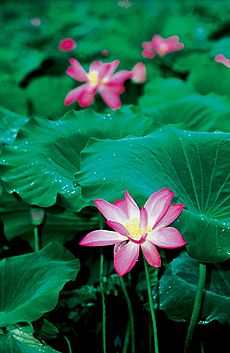
Kakadu has over 2,000 different plant species! This is because the park has many different types of land and habitats. It's also known for being one of the most weed-free national parks in the world.
Each part of Kakadu has its own special plants. In the 'Stone Country', you'll find 'resurrection grasses' that can survive extreme heat and dry conditions, then bounce back with heavy rain. Monsoon forests grow in the cool, moist gorges. Lowland areas are mostly open woodlands with eucalypt trees and many grasses and wildflowers.
The floodplains, which are underwater for several months each year, have sedges, freshwater mangroves, pandanus, and paperbark trees. Beautiful water lilies are common here. Along the coast and tidal flats, you'll see many types of mangroves. These are super important for stopping erosion and providing homes for fish like the barramundi.
Incredible Animals of Kakadu (Fauna)
Kakadu National Park is home to a huge number of animals, many of which are specially adapted to their habitats. Some animals here are rare, endangered, or only found in this area. Because of the extreme weather, many animals are active only at certain times of the day or year.
About 62 mammal species live in the park. Most of them are nocturnal (active at night), so they can be hard to spot. But you might see wallabies and kangaroos during the cooler parts of the day. Larger mammals include Dingos, Antilopine Kangaroos, Black Wallaroos, and Agile Wallabys.
Kakadu's many habitats support over 280 species of birds, which is about one-third of all bird species in Australia!

There are 123 species of reptiles in Kakadu. They need heat from the sun to control their body temperature. Few snakes are active during the midday heat; most are out at night.
Two types of crocodile live in Kakadu: the Freshwater Crocodile (Crocodylus johnstonii) and the Estuarine, or Saltwater Crocodile (C. porosus). Freshwater Crocodiles are smaller (up to 3 metres), while 'salties' can grow over 6 metres!
Kakadu has 25 frog species that are very good at living in the region's extreme climate. Many stay asleep during dry times. When the wet season starts and the billabongs fill with water, the nights are filled with frog sounds.
Fifty-one species of freshwater fish have been found in Kakadu's waterways. The Magela Creek system alone has 32 species!

More than 10,000 species of insects live in Kakadu, including grasshoppers, beetles, butterflies, and termites. The huge termite mounds in the southern part of the park are especially impressive. The colorful Leichhardt’s grasshopper is one of the most spectacular insects found here.
Environmental Challenges and Protection
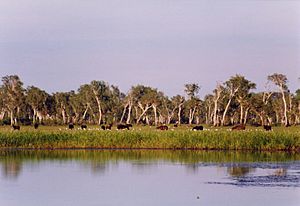
Kakadu has faced challenges from invasive species that threaten the native habitat. These include Water Buffalo, wild pigs, and more recently, the Cane Toad. Invasive weeds like Mimosa pigra and Salvinia molesta also cause problems. Brumbies (wild horses) live in some areas too.
Humans have also changed the area. Buffalo hunting was once common but has been stopped. Crocodile hunting was banned in 1972, and crocodile numbers have recovered well. Mining has changed some landscapes, but only the Ranger mine remains, and its operators must repair the area when it closes.
Managing Fire in Kakadu
Fire is a natural part of Kakadu's landscape. The park has large areas of woodlands and grassy plains that get very dry and hot. The plants here have adapted to frequent fires. Fires in northern Australia are usually less damaging than in the south because many trees are fire-resistant, and other plants grow back quickly.
The national park uses controlled burning, working with traditional owners who have used fire to manage the land for thousands of years. Fire helps Aboriginal people hunt by flushing out prey. It also helps new grass grow, which attracts animals. Birds of prey often fly around fires to catch small animals. Aboriginal people believe that many small fires are better than one large, uncontrolled fire.
Kakadu's Amazing Landforms
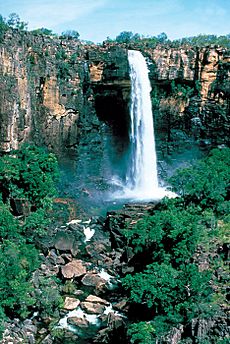
Kakadu National Park has six main types of landforms:
- Savanna woodlands
- Monsoon forests
- Southern hills and ridges
- Stone country of the escarpment
- Coast and tidal flats
- Floodplain and billabongs
Each of these landforms has its own unique habitats. These varied landscapes are a big reason why Kakadu is a World Heritage Area.
About 140 million years ago, most of Kakadu was under a shallow sea. The tall escarpment wall was once sea cliffs. Today, the escarpment rises 330 metres high and stretches 500 kilometres. It has steep cliffs in areas like Jim Jim Falls and isolated rock formations.
The plateau on top of the escarpment is dry, but creeks have carved deep gorges where tall monsoon forests grow. These forests create cool, moist areas for plants and animals, acting as safe havens during the dry season.
The lowland plains cover almost 70% of the park. During the wet season, water from the Arnhem Land plateau floods these plains, bringing rich nutrients. This makes the floodplains full of plant and animal life. In the dry season, the water drains into rivers, creeks, and isolated waterholes called billabongs. Kakadu’s wetlands are recognized internationally for their amazing natural features.
The southern hills and basins are very old, with rocks formed 2,500 million years ago. This area has rugged ridges separated by flat plains.
Kakadu’s coast and tidal river systems stretch about 100 kilometres inland. These areas change a lot between the dry and wet seasons. They are home to many plants and animals that can live in the salty mud, like mangrove swamps.
Ancient Aboriginal Rock Art Sites
The rock art sites of Ubirr, Nourlangie Rock, and Nanguluwur are world-famous examples of Aboriginal rock art. These sites are found in rock shelters where Aboriginal people have lived for thousands of years. The paintings were made for different reasons:
- Hunting: To help increase animal numbers and ensure successful hunts.
- Religious meaning: Some paintings show parts of special ceremonies.
- Stories and learning: Paintings tell stories about the Dreamtime.
- Magic: Paintings could be used to influence events or for fun.
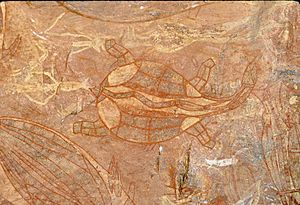
Ubirr is a group of rock outcrops in the northeast of the park. It has large rock overhangs that provided excellent shelter. Because it's near the East Alligator River and floodplains, there would have been plenty of food. This is shown in the rock art, which features animals like barramundi, catfish, goanna, and wallaby. You can also see images of the Rainbow Serpent and mischievous Mimi spirits. These stories are often complex and teach lessons.
Nourlangie is located in an outlying rock formation. It has several shelters with impressive paintings about the Dreamtime. The true meanings of these artworks are known only to certain Aboriginal people. Anbangbang Billabong is nearby and was a great source of food for Aboriginal people.
Nanguluwur, a smaller art site, shows different rock art styles, including hand stencils and mythical figures. There's even a painting of a two-masted sailing ship, showing early contact with non-Aboriginal people.
Visiting Kakadu National Park
Kakadu National Park is a very popular place to visit in northern Australia, with over 200,000 visitors each year. People come to see Kakadu’s amazing landscapes, important Aboriginal culture, and diverse wildlife. There are many beautiful waterfalls and gorges to explore, like Maguk, Gunlom, Twin Falls, and Jim Jim Falls.
You can see some of Kakadu’s wildlife at places like Yellow Water Billabong or Mamukala Wetlands. Kakadu is one of the best places in the world for bird watching, as about 30% of Australia’s bird species can be seen here.
Large saltwater crocodiles are common at Yellow Water and the East Alligator River. The Crocodile Dundee movies were filmed here! Visitors need to be very careful around crocodiles, as they can be dangerous. Fishing is a popular activity, especially for Barramundi, at places like Yellow Water and the South Alligator River. Hunting is not allowed.
There are places to stay in the park, mainly in the town of Jabiru, which also has services like shops and a medical clinic. You can explore Kakadu with a tour operator or drive yourself. Many sites are accessible by regular cars, but some, like Twin and Jim Jim Falls, need four-wheel-drive vehicles.
Park Management and Fees

Kakadu National Park is managed jointly by the Aboriginal traditional owners and the Director of National Parks. The Aboriginal land owners lease their land to the Director of National Parks so it can be enjoyed by everyone. They believe managing it as a national park helps protect their land and culture.
The Kakadu Board of Management, which has more Aboriginal members than non-Aboriginal members, sets the policies for managing the park. They work with the Director to create plans for the park. About one-third of the staff who manage Kakadu every day are Aboriginal people.
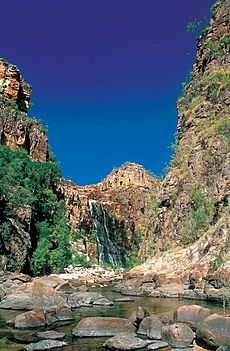
Since April 2010, Kakadu National Park has an entry fee. This money helps manage the park’s natural and cultural values and improves services for visitors. The fee is $25 for interstate and international visitors aged 16 and over, and it's valid for 14 days. Residents of the Northern Territory and children under 16 can enter for free.
Facilities in the Park
Kakadu National Park is connected to Darwin by the Arnhem Highway and to Pine Creek and Katherine by the Kakadu Highway. These roads are usually open all year, but heavy rain can sometimes close them.
Jabiru has hotels, a service station, police, a medical clinic, and shops. It also has a small airport for scenic flights. Other smaller tourist centers like Cooinda and South Alligator offer limited facilities. Cooinda has the Gagudju Lodge Cooinda, Yellow Water Cruises, and the Warradjan Cultural Centre.
There are many camping sites in the park. Some charge a small fee and have showers and toilets, while others are free but have fewer facilities. You can get a list of sites from the Bowali Visitor Centre or their website.
See also
 In Spanish: Parque nacional Kakadu para niños
In Spanish: Parque nacional Kakadu para niños
Images for kids
-
Black wallaroos at Nourlangie Rock




